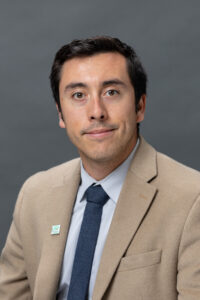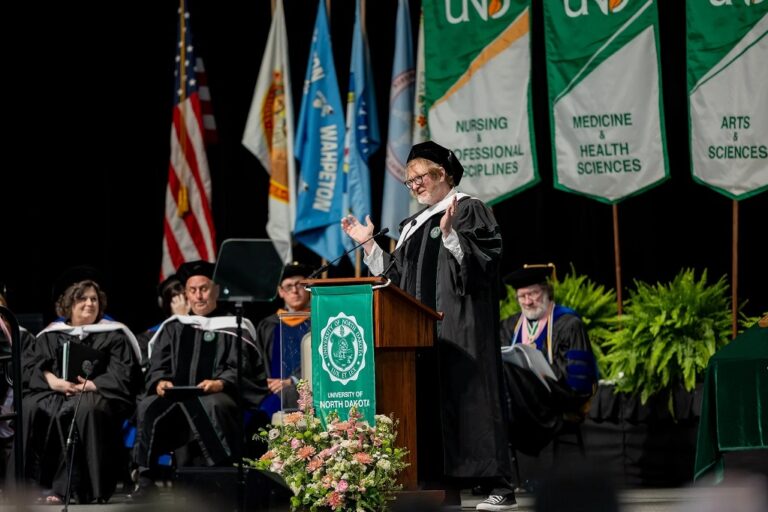Want to protect the environment? Look to the periodic table
Consider your ‘elemental footprint’ in addition to your carbon footprint, says Princeton University’s Paul Chirik at Abbott Chemistry Lecture

How well do you know the periodic table?
Though your answer may be “Not well,” you actually interact with about two-thirds of the 118 elements present in the natural world in your daily life.
That’s according to Paul Chirik, professor of chemistry at Princeton University, who delivered the annual Abbott Chemistry Lecture last month. Chirik’s talk was titled “Re-Imagining the Periodic Table: the Elements and You,” and his research interests center around sustainability and catalysis – the process of speeding up chemical reactions through added substances known as catalysts.
The lecture series is named after George A. Abbott, former professor emeritus who taught and chaired the Department of Chemistry at UND from 1910 to 1952. He also served as North Dakota’s state toxicologist until his retirement in 1970.
On a given day, Chirick said, humans directly interact with between 75-80 elements present on the periodic table. Many of these elements are scarce and consequently, require extensive resources to extract.
“What that tells you, is your lifestyle is inherently unsustainable,” he said. “And it has to do with more than carbon. You really need to worry about your elemental footprint.”
Smart phones are a major contributor to our elemental footprint, due to the presence of elements such as tin that are often mined in poor working conditions, he said.
For example, the working conditions in Bolivian mines – where the bulk of the world’s tin is mined – can be described in stark terms:
“An average Bolivian tin miner works 12-hour shifts, has no food, and I think most sadly is that their life expectancy is only 40 years,” Chirik said.
“The western world tends to do this in places we don’t want to think about,” he added. “We think we’re doing net good for the planet, but someone else bears the environmental burden.”
Chirik also cautioned against the elemental footprint associated with certain forms of renewable energy, namely wind power. Think neodymium, a rare earth element used in the magnets that help wind turbines generate electricity, coupled with several tons of non-recyclable plastic and concrete – the latter of which is “one of the largest sources of carbon dioxide emissions on the planet.”
“If the Netherlands (a nation of around 18 million) meets its green ambitions, it will consume the entire world’s supply of these minerals,” Chirik said. “That tells us we really should rethink some of these ideas behind alternative energy, if the elemental dependency is going to be what it currently is. We simply can’t do it.”

Moving to the subject of catalysis, Chirik said the process interfaces with nearly every aspect of daily life, including the manufacturing of clothing, pharmaceuticals and consumer electronics.
“It’s responsible for 80% of the chemical products on the market, and 35% of global GDP,” he said.
However, the process requires rare, expensive elements such as palladium, platinum and rhodium. Furthermore, the global supply of palladium – of particular importance to the pharmaceutical industry – is largely controlled by Russia, whose invasion of Ukraine “completely changed the palladium market overnight.”
And this high cost of palladium also contributes to the high cost of lifesaving drugs.
A prominent example are drugs used to treat HIV/AIDS. While research and development has reduced the burden of treatment, the high cost of palladium used to manufacture the needed drug places it out of reach of the population most in need: those living with HIV/AIDS in sub-Saharan Africa.
“In the 80s and early 90s, AIDS was a death sentence,” he said. “This is where chemistry should be admired by the masses. However, it turns out that 30% of the cost of the synthesis of this molecule comes from the use of palladium. That drives up the cost so much that you can’t give it to people in the developing world.”
These factors are leading Chirik and his team of researchers to practice what he calls “modern alchemy,” the process of transmuting more abundant elements (such as iron, nickel and cobalt) into effective catalysts.
One such initiative is a partnership with the Medicines for All Institute, housed at Virginia Commonwealth University’s College of Engineering. Bolstered by a $70 million endowment from the Bill and Melinda Gates Foundation, the institute is working to reduce the cost of producing more than 20 drugs.
“We’re nowhere near something that’s commercially viable yet, but we’ve discovered in the past three months that nickel can do some of the same chemistry that palladium can,” he said.
Chirik concluded by stating that policymakers should focus on more efficiently extracting hydrocarbons and producing plastic, and that blanket bans on fossil fuels are simply unrealistic.
“You’re wearing a barrel of oil whether you know it or not,” he said. These days, window frames are made out of PVC; but “if you wanted to pull out every window frame on planet earth, you’d have to chop down every single tree to replace them. … You can make a hip joint, plastic bag, car bumper and yogurt cup all from carbon and hydrogen. That’s an amazing triumph of chemistry, catalysis and materials science.”
The issue with plastics, Chirik said, is how they are disposed of. At present, one kilogram of plastic generates around 2 1/2 kilograms of carbon dioxide.
“The answer isn’t banning plastic, it’s producing better plastic,” he said. “Better plastic means designing it to be thrown away. Almost nothing we use is designed that way. What we need is a new hydrocarbon age – one that gets rid of the carbon dioxide footprint associated with making these things, and that really focuses on the end of life and how we throw the items away.”



